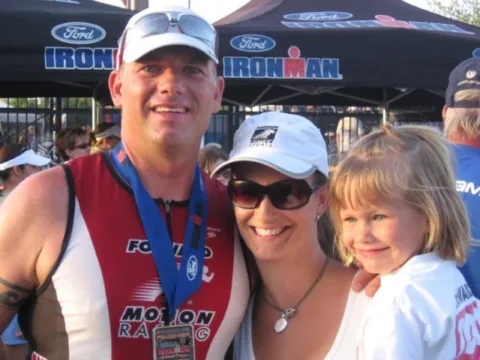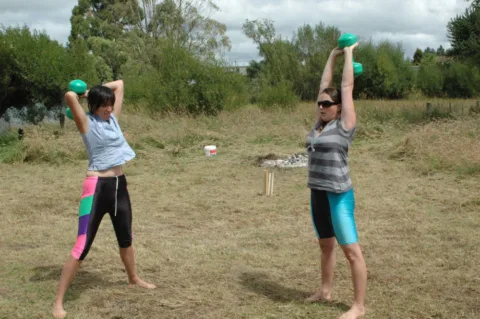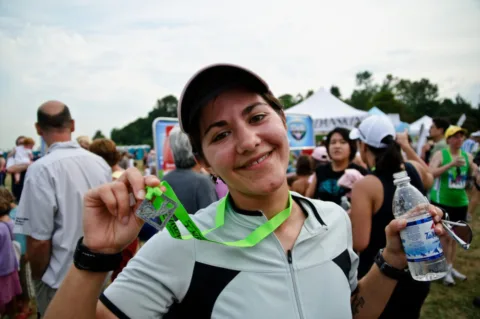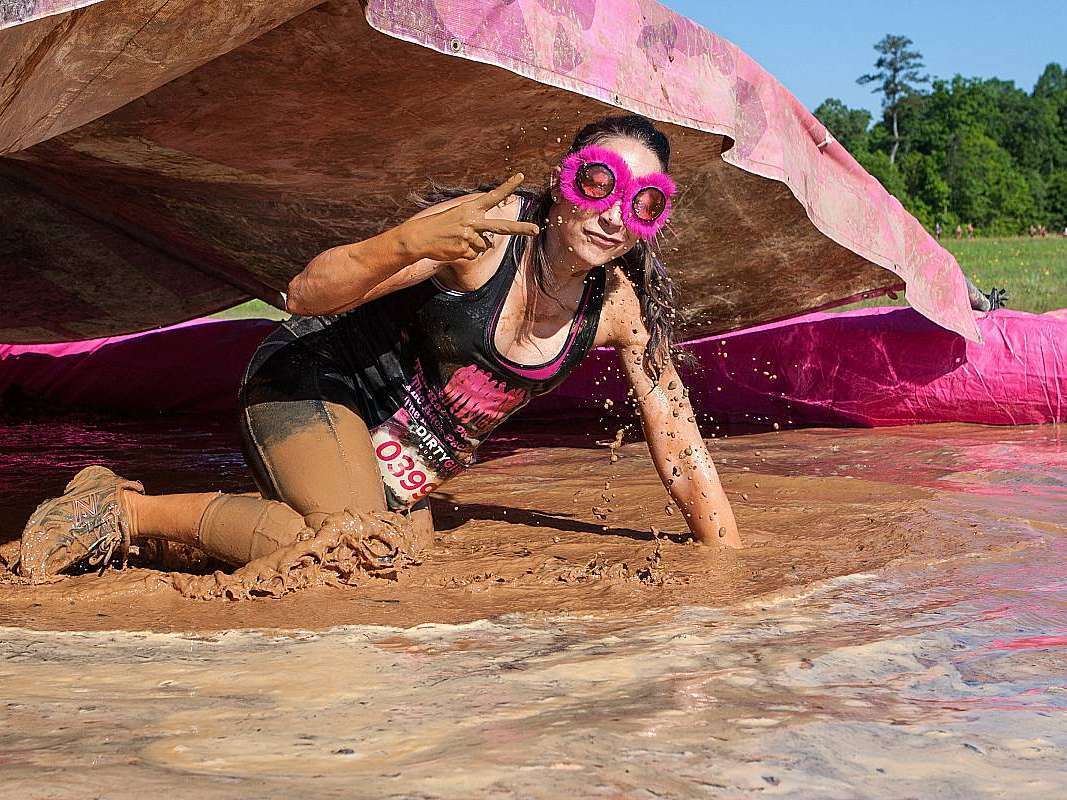Are you a beginner triathlete? A newbie to the sport?
Many people become interested in the sport of triathlon in the months of December, January, and February.
Looking ahead to a new year, people set new goals for themselves — which are often associated with some aspect of health and fitness. Choosing the sport of triathlon has become more common as the sport has grown in popularity and offers the advantages of cross-training.
For some, becoming a triathlete is combined with the desire to lose weight and be in optimal health.
The reasoning often used to assure people that anyone can be a triathlete is that it involves doing 3 things that virtually every person enjoyed doing as kids: swimming, biking, and running.
Yes this is true, but there are several elements involved in fulfilling the desire to be a triathlete such as:
- Choosing a specific triathlon event to train for
- Building a triathlon-ready level of fitness
- Selecting the right triathlon gear, equipment, and sportswear
- Establishing a year-round systematic training plan and weekly schedule
- Fueling your body with proper nutrition
- Preventing and treating injuries
- Learning proper technique for swimming, biking, and running
- Developing the skill of open-water swimming
- Managing the specifics of competing in a triathlon event
Like most goals worth achieving, becoming a triathlete is going to require an investment of time, physical and mental energy, and financial resources.
It is likely you will need to make certain lifestyle adjustments in order to free-up the time, energy, and resources necessary to train and race in triathlons.
Though there are certain foundational principles for all triathlon training, there is no one-size-fits-all triathlon training plan. The reason is that there are no two triathletes who are the same.
For example, right now you are located someplace on a long continuum of fitness level, knowledge, and skill. Your physiological and psychological makeup is unique. You may or may not have some background in one of the 3 sports involved in triathlon: swimming, biking, and running. You have certain time, financial, perhaps even physical limitations that you must take into account. All of these and other factors will influence your specific triathlon training plan.
It can all seem quite overwhelming, and sometimes it’s difficult knowing where to begin.
Here’s how I would approach getting started for a newcomer to the sport of triathlon…
By the way, for the purposes of this post, I’m going to assume the following about you:
- You are not a totally inactive or couch-potato kind of person, but you have not been working out regularly and could stand to shed some extra pounds.
- Your current bike is not acceptable, and you’re not sure if you remember how to swim.
- Doing a triathlon represents a big challenge, but you are 100% totally determined to do it!
For a person such as this, what follows is a plan of action to jump-start you on your way in the sport of triathlon.
Knowledge Before Action
Think about that list of items I identified in the beginning of this post that relate to the sport of triathlon.
In each area, it’s important that you apply a simple principle: knowledge before action. Many new triathletes are people who know just enough to be dangerous. With insufficient knowledge and understanding, they make hasty decisions and hasty purchases they often prove to regret.
For example, walking into a bike shop with minimal knowledge of your bike needs as a triathlete, or the bike options available, is not advisable. Even smaller purchases such as goggles, water bottles, and running socks require knowledge.
Visiting this site regularly will help you acquire greater knowledge and understanding for all aspects of training and competing in triathlons. There are also some helpful books about triathlon training that would be worth your time reading. A few are:
- The Triathlete’s Training Bible by Joe Friel
- Swim, Bike, Run by Town and Kearney
- Triathlete Magazine’s Complete Triathlon Book
- Triathlon 101 by John Mora
- Triathlon Swimming Made Easy by Terry Laughlin
Begin Building Fitness Now
You might wonder from my first point if all your time needs to be spent reading books, or earning a Masters degree in multi-sport endurance training. Not!
Start building your fitness today. There are at least 2 things you can begin doing right away — even if you don’t yet have a bike, or it’s too cold to train outside.
Whether it’s outdoors or on a treadmill, one thing you can begin doing immediately is start running. There’s always more to learn, even about running. But, for the most part, running is fairly straightforward. This might require your first major purchase for triathlon training, running shoes. Spend some time to acquaint yourself with the running shoe options and which running shoe is likely to be the best for you.
The second thing you can do right away is start taking spin classes. This will help get you going in the area of cycling. Assuming you belong to some sort of gym, it’s likely they have spin or group cycle classes. The class instructor will help you determine the proper seat height and other necessary adjustments. A simple weekly plan to start would be to rotate the days you spin and run – on Monday, Wednesday, Friday do a spin class; on Tuesday, Thursday, and Saturday go for a run.
If you feel there is a health or medical issue that might hinder your training, schedule a visit with your doctor for a check-up and discuss your questions and concerns with your doctor. Many new triathletes make the mistake of overdoing it. Start small and increase incrementally. I suggest you focus more at first on increasing time of training as opposed to mileage.
For example, a spin class is normally 45 minutes to 1 hour. Expect that it will take some time for you to build up to the intensity level the instructor is encouraging in the class. With running, starting with a 20-minute run and incrementally increasing that time to 60 minutes with help you begin building an endurance base for running. As you begin training, be aware of your need to stay hydrated with water.
Make A Next-Step List Now
As you grow in knowledge, you will begin identifying the major next steps you will need to take. Some of the most significant ones might be:
- learning how to swim freestyle properly
- purchasing a bike for your first triathlon
- determining your triathlon goals, and identifying a specific race for your first triathlon
- making changes in your diet, and following a nutrition plan
- establishing a more comprehensive and systematic triathlon training plan
- finding a triathlon training partner
Make a list and begin scratching them off one by one.
Be A Triathlete Now
The time it takes to do an actual triathlon race is minuscule compared to the amount of time you invest in triathlon training year round.
You are a triathlete not just because you do one or more triathlons, but also because you have made a commitment to the fitness, nutrition, and training lifestyle relative to the sport of triathlon. So, think of yourself right now as a triathlete.
Even in these early stages, you will be dealing with all the ups and downs of being a triathlete. There will be good days and not so good days, days when you feel progress is being made and days you wonder if you’re digressing, some days you’ll feel ready to take on the world and other days you’ll feel too sore to get out of bed, one day you will be on a triathlon high and the next day you may want to sell your bike.
But through it all, the thing that will ultimately set you apart as a triathlete is endurance. Through all those ups and downs, progress and setbacks, good days and bad days, the joy and the pain, you must and you will endure.
You can do it!
See you on race day. Welcome to the sport of triathlon.






